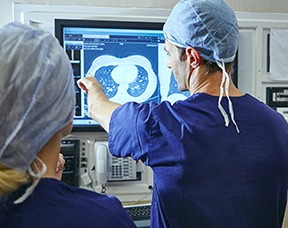A lymph node biopsy, also referred to as a lymph node dissection or lymphadenectomy, is an outpatient procedure that involves the removal of one or more lymph nodes. Harvested tissue is then examined under a microscope to see if they contain any cancerous cells. The procedure itself isn’t always done for prostate cancer necessarily but is performed to determine if the cancer has metastasized from the prostate gland into nearby lymph nodes.
Procedure & Types
- Fine-needle aspiration (FNA): A needle biopsy is generally performed by a radiologist using either a CT scan or ultrasound to help guide the needle during the procedure. Before beginning your doctor will numb the area where the needle will be inserted. Once the area is numbed, the needle is then put through the skin and into the lymph node. The collected samples are then sent to a lab to be examined.
- Core needle biopsy: This procedure is normally performed by either a general surgeon or radiologist. As with a fine-needle aspiration the area where the lymph node samples will be harvested is numbed first. A small incision is then made in the skin followed by the insertion of a needle with a specialized tip. Lymph node samples that are harvested to be examined are no bigger than a grain of rice.
- Open biopsy (surgical): An open biopsy is performed by a surgeon and for For a lymph node that is near the surface of the skin, the biopsy site will be numbed with local anesthetic prior to the procedure. The area is then cleansed and covered with a sterile sheet. A small incision is made so either the lymph node or a portion can be removed. The area will then be stitched up and bandaged. You can normally return to your normal activities the next day following the procedure..
Side Effects/Risks
As with any kind of surgical procedure there are risks and side effects associated with a lymph biopsy that include:
- tenderness around the biopsy site
- infection
- bleeding
- numbness caused by incidental nerve damage
- fever
- chills
- swelling
- intense pain
- bleeding or discharge from the biopsy site
Some pain and tenderness is typical and can last for several days following the biopsy. It’s also important to keep the biopsy site clean and dry at all times. Your doctor may also suggest that you avoid showers and baths during the recovery period to avoid any further complications.
Results
Test results of a lymph node biopsy are usually available within a few days. Finding certain types of infections however may take a bit longer.The lymph node sample is usually treated with special dyes (stains) that color the cells to make problems more visible.
Normal:
- The lymph node has normal numbers of lymph node cells.
- The structure of the lymph node and the appearance of the cells in it are normal.
- There are no signs of infection
Abnormal:
- Signs of infection are present and may be an indicator of other medical conditions such as tuberculosis (TB) or rheumatoid arthritis.
- Cancerous cells may be present within the lymph nodes or may have spread into other areas of the body.
If the test results of your lymph node biopsy rules out the presence of cancerous cells, your doctor may have you undergo additional medical testing to ascertain the the root cause for the enlargement of your lymph nodes. Be sure to also bring up any questions or concerns you may have regarding the results of your biopsy when speaking with your doctor.


